Abstract
The legacy monolithic systems in enterprises can be migrated to Virtual machines (VMs) or can be converted to containers. This article explains the features and components of Virtual machines and Containers.
Introduction
Containers are used to create small microservice or software process to a larger application. Containers run with a single operating system (OS) and share memory, libraries, and resources. Containers don’t contain Operating system image.
Virtualization is creating Virtual machines (VMs), by installing software components -Hypervisor on physical servers. Each instance needs a separate Operating system (OS).
Virtual Machines (VMs) and Containers
Virtual Machines (VMs):
Virtual machines are created by installing the Hypervisor software component on a physical server. This allows users to create their own resources.
Each VM that is created acts as a separate server with this own Operating system (OS). This approach causes high operating costs.

Containers:
The host Operating system is virtualized in Containers. Containers run on single OS and share memory, libraries and resources.
The monolithic applications can be broken down into small components based on their functionality, and these components are called as microservices. The microservices are wrapped inside containers.
The containers are independent components that are designed to perform specific functions.

Advantages of Containers.
Containers provide the following advantages:
- Containers once developed can be deployed across different environments.
- Containers work separately, providing better security, i.e. if there is an issue with one container, this can be handled separately without affecting the overall system.
- Containers can be easily scaled up or down based on business demand.
Container Solutions
Docker is a popular tool used to build container-based solutions. Docker is a standalone software that can be installed on any computer to run containerized applications.
If docker has been installed on a bunch of hosts (i.e different OS), Kubernetes can be utilized to manage these Docker hosts or Nodes to automate container provisioning, networking, load balancing, scaling and security across all nodes from a single command line or dashboard.
The collection of nodes managed by single Kubernetes instance is called a Kubernetes cluster.
Conclusion:
Designing software for a container-based platform makes applications easy to maintain, scalable and provides better security due to its modularity. Virtual machines have their own limitations as each VM needs separate OS, and this increases the cost and maintenance of these VMs is complex compared to container-based applications.

 English | EN
English | EN 